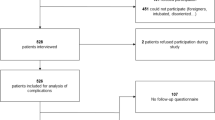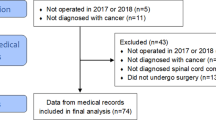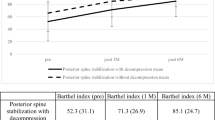Abstract
Study design:
Retrospective cohort study.
Objective:
Data on patient outcomes after surgery for spinal cord tumors have been derived from single-institution series. The objective of this study is to report inpatient complications, mortality and outcomes on a national level.
Setting:
United States, national inpatient care database.
Methods:
The National Inpatient Sample (NIS) was used to identify 19 017 admissions for resection of a spinal cord tumor in the United States from 1993 to 2002. The effects of patient and hospital characteristics on inpatient outcomes were analyzed using logistic regression.
Results:
The in-hospital mortality rate and the complication rate were 0.55 and 17.5%, respectively. Urinary and renal complications (3.7%), postoperative hemorrhages or hematomas (2.5%) and pulmonary complications (2.4%) were the most common complications reported. A single postoperative complication increased the length of stay by 4 days, increased the mortality rate by sixfold and added over $10 000 to hospital charges. Multivariate analysis showed that complications were more likely in African Americans and patients with multiple comorbidities. The odds of an adverse outcome increased significantly with age greater than 64, multiple comorbidities and postoperative complications.
Conclusion:
A national perspective on inpatient outcomes after resection of spinal cord tumors has been provided. The significant negative impact of postoperative complications on mortality and resource utilization has been demonstrated. We have identified advanced age and multiple comorbidities as risk factors that predict adverse outcome. Furthermore, this study highlights the importance of avoidance, recognition and prompt management of nonneurologic complications.
Similar content being viewed by others
Log in or create a free account to read this content
Gain free access to this article, as well as selected content from this journal and more on nature.com
or
References
Tihan T, Chi JH, McCormick PC, Ames CP, Parsa AT . Pathologic and epidemiologic findings of intramedullary spinal cord tumors. Neurosurg Clin N Am 2006; 17: 7–11.
Parsa AT, Lee J, Parney IF, Weinstein P, McCormick PC, Ames C . Spinal cord and intradural-extraparenchymal spinal tumors: current best care practices and strategies. J Neurooncol 2004; 69: 291–318.
Healthcare Cost and Utilization Project (HCUP). Agency for Healthcare Research and Quality: Rockville, MD, 2004.
Elixhauser A, Steiner C, Harris DR, Coffey RM . Comorbidity measures for use with administrative data. Med Care 1998; 36: 8–27.
Patil CG, Lad SP, Santarelli J, Boakye M . National inpatient complications and outcomes after surgery for spinal metastasis from 1993–2002. Cancer 2007; 110: 625–630.
Barker II FG . Craniotomy for the resection of metastatic brain tumors in the US, 1988–2000: decreasing mortality and the effect of provider caseload. Cancer 2004; 100: 999–1007.
Agency for Healthcare Research and Quality. Calculating Nationwide Inpatient Sample Variances. Agency for Healthcare Research and Quality: Rockville, MD, 2002.
Chang UK, Choe WJ, Chung SK, Chung CK, Kim HJ . Surgical outcome and prognostic factors of spinal intramedullary ependymomas in adults. J Neurooncol 2002; 57: 133–139.
Epstein FJ, Farmer JP, Freed D . Adult intramedullary spinal cord ependymomas: the result of surgery in 38 patients. J Neurosurg 1993; 79: 204–209.
Hanbali F, Fourney DR, Marmor E, Suki D, Rhines LD, Weinberg JS et al. Spinal cord ependymoma: radical surgical resection and outcome. Neurosurgery 2002; 51: 1162–1172, discussion 1172–1174.
Lee HK, Chang EL, Fuller GN, Aldape KD, Atkinson GJ, Levy LB et al. The prognostic value of neurologic function in astrocytic spinal cord glioma. Neuro Oncol 2003; 5: 208–213.
McCormick PC, Stein BM . Intramedullary tumors in adults. Neurosurg Clin N Am 1990; 1: 609–630.
Samii M, Klekamp J . Surgical results of 100 intramedullary tumors in relation to accompanying syringomyelia. Neurosurgery 1994; 35: 865–873 discussion 873.
Shirato H, Kamada T, Hida K, Koyanagi I, Iwasaki Y, Miyasaka K et al. The role of radiotherapy in the management of spinal cord glioma. Int J Radiat Oncol Biol Phys 1995; 33: 323–328.
Author information
Authors and Affiliations
Corresponding author
Rights and permissions
About this article
Cite this article
Patil, C., Patil, T., Lad, S. et al. Complications and outcomes after spinal cord tumor resection in the United States from 1993 to 2002. Spinal Cord 46, 375–379 (2008). https://doi.org/10.1038/sj.sc.3102155
Received:
Revised:
Accepted:
Published:
Issue date:
DOI: https://doi.org/10.1038/sj.sc.3102155
Keywords
This article is cited by
-
Effect of race, sex, and socioeconomic factors on overall survival following the resection of intramedullary spinal cord tumors
Journal of Neuro-Oncology (2023)
-
Efficacy analysis of two surgical treatments for thoracic and lumbar intraspinal tumours
BMC Surgery (2019)
-
Management and outcome in adult intramedullary spinal cord tumours: a 20-year single institution experience
BMC Research Notes (2014)



